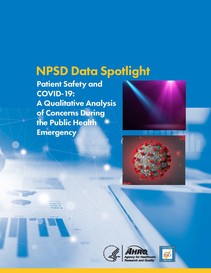| December 14, 2021, Issue #793 Appendectomy was the most common operating room procedure during inpatient stays for children aged 0-17 in 2018, with over 17,000 performed on females and about 26,000 performed on males. (Source: AHRQ, Healthcare Cost and Utilization Project Statistical Brief #281, Overview of Operating Room Procedures During Inpatient Stays in U.S. Hospitals, 2018.)  Two AHRQ-supported studies found that communication practices as well as the knowledge, beliefs and experiences of caregivers impacted flu vaccination of children while they were in the hospital. In a study published in Academic Pediatrics, researchers surveyed 194 caregivers of hospitalized children to determine whether they planned to vaccinate during hospitalization. Of those who initially had hadn't thought about vaccination or planned to decline the vaccine, 22 percent decided to accept the vaccine, with 67 percent of those citing a conversation with a healthcare professional as the main reason for changing their mind. A second study published in Hospital Pediatrics found caregivers who believed that flu vaccines were important for their child's health was the strongest positive predictor of vaccinating their hospitalized children. In addition, caregiver vaccine hesitancy and agreement that vaccination should be deferred during acute illness were the strongest negative predictors. These factors can serve as a critical step to designing effective, evidenced-based interventions to identifying vaccination opportunities during children's hospitalizations. . |  AHRQ has released new modules to help nursing home staff identify and manage emotions and stress. Each module is self-paced and covers a specific topic: identifying and overcoming anxiety; recognizing and reducing stress; and using open communication to overcome stress. The modules explain the importance of addressing stress and provide strategies and techniques. A brief user guide, talking points and print materials for promoting them to staff are included. Access the modules. |  A new analysis of nearly 5,500 records of patient safety concerns voluntarily reported for inclusion in AHRQ's Network of Patient Safety Databases (NPSD) found that a patient testing positive for COVID-19 or being investigated for carrying the virus was the most frequently reported concern in more than one-fourth of the records (26.6 percent). The NPSD, an evidence-based management resource for healthcare providers, Patient Safety Organizations and others, was established to encourage voluntary reporting of information that could be used for national learning to improve patient safety and prevent harm. In more than 18 percent of the records analyzed, exposure of patients and staff to individuals who had tested positive for COVID-19 was identified as a patient safety issue or unsafe condition. Access the new Data Spotlight, Patient Safety and COVID-19: A Quantitative Analysis of Concerns During the Public Health Emergency. | AHRQ's Patient Safety Network (PSNet) highlights journal articles, books and tools related to patient safety. Articles featured this week include: Review additional new publications in PSNet's current issue or access recent cases and commentaries in AHRQ's WebM&M (Morbidity and Mortality Rounds on the Web).  There is significant variation in care instructions for home pulse oximeters prescribed to children receiving home oxygen, according to an AHRQ-funded study published in Pediatric Pulmonology. The authors analyzed pediatric home pulse oximetry orders for 368 children prescribed through a large U.S. children's hospital from June 2018 to July 2019. Orders were most frequently prescribed on non-cardiac medical floors. They found that 96 percent of orders included information on frequency of use; however, just 70 percent provided care instructions after alarm activation. The authors suggested that given the frequency of home pulse oximeter use, the lack of published guidelines for home pulse oximetry monitoring for children is a critical gap. Access the abstract. | Registration is open for a webinar on Jan.12 from 2 to 3 p.m. ET about how AHRQ's Surveys on Patient Safety Culture™ (SOPS®) can help healthcare providers and staff learn about the extent to which their organizational culture supports patient safety. Speakers will describe the SOPS program, surveys, supplemental items, databases and resources available to users, and will highlight upcoming activities. | AHRQ in the Professional Literature Weak correlations in health services research: weak relationships or common error? O'Malley AJ, Landon BE, Zaborski LA, et al. Health Serv Res. 2021 Sep 28. [Epub ahead of print.] Access the abstract on PubMed®. A shared decision-making tool for drug interactions between warfarin and nonsteroidal anti-inflammatory drugs: design and usability study. Reese TJ, Del Fiol G, Morgan K, et al. JMIR Hum Factors. 2021 Oct 26;8(4):e28618. Access the abstract on PubMed®. Pre- and peri-operative factors associated with chronic critical illness in liver transplant recipients. Ingraham NE, Tignanelli CJ, Menk J, et al. Surg Infect. 2020 Apr;21(3):246-54. Epub 2019 Oct 16. Access the abstract on PubMed®. A cross-cutting workforce solution for implementing community-clinical linkage models. Islam N, Rogers ES, Schoenthaler A, et al. Am J Public Health. 2020 Jul;110(S2):S191-s3. Access the abstract on PubMed®. Increasing Medicaid's stagnant asset test for people eligible for Medicare and Medicaid will help vulnerable seniors. Cornelio N, McInerney MP, Mellor JM, et al. Health Affairs. 2021 Dec;40(12):1943-52. Access the abstract on PubMed®. Optimal staffing in community health centers to improve quality of care. Luo Q, Dor A, Pittman P. Health Serv Res. 2021 Feb;56(1):112-22. Epub 2020 Oct 8. Access the abstract on PubMed®. Evaluation of an intrahospital telemedicine program for patients admitted with COVID-19: mixed methods study. Legler S, Diehl M, Hilliard B, et al. J Med Internet Res. 2021 Apr 29;23(4):e25987. Access the abstract on PubMed®. Translational simulation improves compliance with the NEAR4KIDS Airway Safety Bundle in a single-center PICU. Colman N, Newman JW, Nishisaki A, et al. Pediatr Qual Saf. 2021 May-Jun;6(3):e409. Epub 2021 May 19. Access the abstract on PubMed®. Contact Information For comments or questions about AHRQ News Now, contact Bruce Seeman, (301) 427-1998 or Bruce.Seeman@ahrq.hhs.gov. |






No comments:
Post a Comment